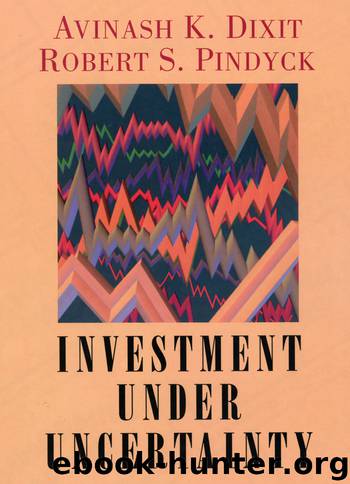Investment under Uncertainty by Dixit Robert K.; Pindyck Robert S.;

Author:Dixit, Robert K.; Pindyck, Robert S.;
Language: eng
Format: epub
Publisher: Princeton University Press
2.A Rules for Optimal Switches
In the previous section we denoted the cost of abandoning a live project by E. Now we are letting EM be the cost of mothballing an operating project, and Es be the cost of scrapping a project already in mothballs. (In the case of a mine, the former may be the cost of firing the miners and the latter the cost of site restoration. With a ship, the latter may be negative, representing the scrap value.) To keep the exposition simple, we will assume that EM + ES = E, so the cost of directly abandoning an active project is just the sum of the costs of mothballing it first and then abandoning the mothballed project. In practice, going from an operational project to total scrapping may be more or less costly when done via the stage of mothballing. Costs of preparing a ship and moving it to and from the lay-up location may have to be incurred twice, but there may be some saving in labor firing costs if the more gradual route allows the labor force reduction to be achieved by retirement or quits. We leave it to the reader to examine the issues raised by such nonadditivity of costs.
Similar considerations apply to the investment cost I. In principle, one can imagine installing a project in the mothballed state at a cost J, say, and then activating it later at a cost R. However, we see little reason why this indirect route should ever be cheaper than simply investing in an operating project. Hence the firm will never find it optimal to take this route; it will never invest into a mothballed project. By postponing investment until the instant of operation, it can delay spending the first tranche J of capital cost, and save on the flow M of maintenance cost.8
This leaves us one less switch to consider among the possible six switches that are conceivable across the three states. Of the remaining five switches—idle to live, live to mothballed, mothballed to scrap, mothballed to live, and live to scrap—the first four are used if mothballing is actually a part of the optimal strategy. Otherwise only the first and the last are used. We proceed for a while on the assumption that when price falls to a certain point, mothballing is used, and then determine its limits of validity during the course of the analysis.
We will continue to denote the idle and operating states by the labels 0 and 1, respectively, and we introduce the additional label m for the mothballed state. We find the value of the firm in each state as the appropriate combinations of the expected profit or cost streams and the options to switch. The method is exactly the same as that used earlier in this chapter, and in chapters 5 and 6, so we will sketch out the analysis and omit many of the details.
The firm can be in the idle state over the interval (0, PH) of prices.
Download
This site does not store any files on its server. We only index and link to content provided by other sites. Please contact the content providers to delete copyright contents if any and email us, we'll remove relevant links or contents immediately.
| Corporate Finance | Crowdfunding |
| Financial Engineering | Financial Risk Management |
| Wealth Management |
The Black Swan by Nassim Nicholas Taleb(7010)
Bad Blood by John Carreyrou(6543)
Pioneering Portfolio Management by David F. Swensen(6226)
Millionaire: The Philanderer, Gambler, and Duelist Who Invented Modern Finance by Janet Gleeson(4374)
Skin in the Game by Nassim Nicholas Taleb(4161)
Bullshit Jobs by David Graeber(4094)
The Money Culture by Michael Lewis(4074)
Skin in the Game: Hidden Asymmetries in Daily Life by Nassim Nicholas Taleb(3929)
The Wisdom of Finance by Mihir Desai(3650)
Blockchain Basics by Daniel Drescher(3495)
Liar's Poker by Michael Lewis(3367)
Fooled by Randomness: The Hidden Role of Chance in Life and in the Markets by Nassim Nicholas Taleb(3043)
Hands-On Machine Learning for Algorithmic Trading by Stefan Jansen(3027)
The Intelligent Investor by Benjamin Graham Jason Zweig(2995)
Mastering Bitcoin: Programming the Open Blockchain by Andreas M. Antonopoulos(2980)
The Power of Broke by Daymond John(2896)
Investing For Dummies by Eric Tyson(2893)
Market Wizards by Jack D. Schwager(2643)
Zero Hour by Harry S. Dent Jr. & Andrew Pancholi(2614)
